
Hindustan Unilever Limited (HUL) has recently announced its Q4 FY25 earnings and declared a final dividend of ₹24 per share, which has influenced its stock price. Despite a slight dip in the stock after the announcement, the overall impact seems to be positive in terms of the company’s long-term performance.
Lets take a look at the financial results, dividend details, and stock performance!
A snapshot of HUL’s financial performance
HUL, one of India’s leading FMCG companies, has continued to report steady revenue and profit growth. For the Q4 FY25, HUL’s net profit rose by 3.7% YoY to ₹2,493 crore, slightly above analysts’ estimates. The company reported ₹15,214 crore in revenue, marking a 2.4% increase YoY.
HUL Financials at a glance:
| Metric | FY 2025 | FY 2024 | YoY Growth |
| Revenue | ₹15,214 Cr | ₹14,857 Cr | +2.4% |
| EBITDA | ₹3,466 Cr | ₹3,435 Cr | +0.9% |
| EBITDA Margin | 23.1% | 23.4% | -0.3% |
| Net Profit | ₹2,493 Cr | ₹2,406 Cr | +3.7% |
While there was growth in overall revenue, the company faced pressure on its margins due to higher input costs and weak urban demand. Despite these challenges, HUL’s ability to maintain a stable EBITDA margin is a strong point for long-term investors.
Also read: IndusInd Bank shares dip 6% on audit
Dividend details:
The final dividend of ₹24 per share is a part of the total ₹53 per share payout for FY25, which includes the interim dividend of ₹19 and a special dividend of ₹10 declared in November 2024. This makes HUL’s dividend a major selling point for investors looking for steady returns.
HUL Dividend Breakdown:
| Dividend Type | Amount per Share |
| Interim Dividend | ₹19 |
| Special Dividend | ₹10 |
| Final Dividend | ₹24 |
| Total Dividend FY25 | ₹53 |
For investors, this dividend payout is an important factor to consider, as it shows the company’s strong financial standing and commitment to rewarding shareholders.
Also read: Alok Industries breaks losing streak after Q4 results
HUL share price performance
Following the announcement of the results and the final dividend, HUL’s share price saw a slight decrease, from ₹2,423 per share to ₹2,397 per share. Despite this short-term dip, HUL has remained relatively stable in the market. Over the past year, its stock has gained 10%, which suggests that HUL continues to maintain its leadership in the FMCG sector.
Here’s how HUL’s stock has performed recently:
| Time Period | Price Change |
| 1-Year | +10% |
| YTD (Year-to-Date) | +7% |
| Past 6 Months | -1% |
Despite the recent drop, the long-term outlook remains positive, as investors continue to value HUL’s brand strength, product diversity, and dividend payout.
Segment-wise performance: Where does HUL stand?
HUL operates across various business segments like Personal Care, Beauty & Wellbeing, Home Care, and Foods & Beverages. While Beauty & Wellbeing and Home Care segments saw modest growth, Foods experienced a decline due to category headwinds, though ice cream and coffee performed well.
- Personal Care: Growth slowed, with a 3% increase in revenue but low-single-digit volume declines.
- Beauty & Wellbeing: Growth of 3% led by strong performance in hair care.
- Home Care: The segment grew by 3%, driven by premium fabric care products.
- Foods: This segment saw a 1% decline as price increases could not offset volume declines in some categories.
Despite these challenges, HUL’s premium brands and strong market presence have allowed it to continue growing, albeit at a slower pace than in previous years.
You may also like: ICICI Bank Q4 results key takeaways
Should you invest in HUL shares?
Advantages of investing in HUL:
- Consistent dividend payout: HUL’s reliable dividends are attractive to long-term investors seeking steady returns.
- Strong brand presence: HUL’s FMCG brands are some of the most recognized and trusted in India, making it a leader in the market.
- Diverse portfolio: The company’s diverse segments give it the flexibility to weather different market conditions.
Disadvantages to consider:
- Margin pressure: Rising input costs and weak urban demand are significant risks to HUL’s margin expansion.
- Slower growth: While the company is still growing, the pace has slowed, and there are concerns about future volume growth in some categories.
Bottom line
HUL continues to be a leader in the FMCG sector, with solid dividend returns and a stable market position. While short-term growth may be under pressure, the company’s long-term fundamentals remain strong.
HUL for long-term investors offers a stable return via dividends and consistent market performance. However, short-term traders might want to proceed cautiously due to potential volatility in the coming months. Always do thorough research before making any investment decisions.
